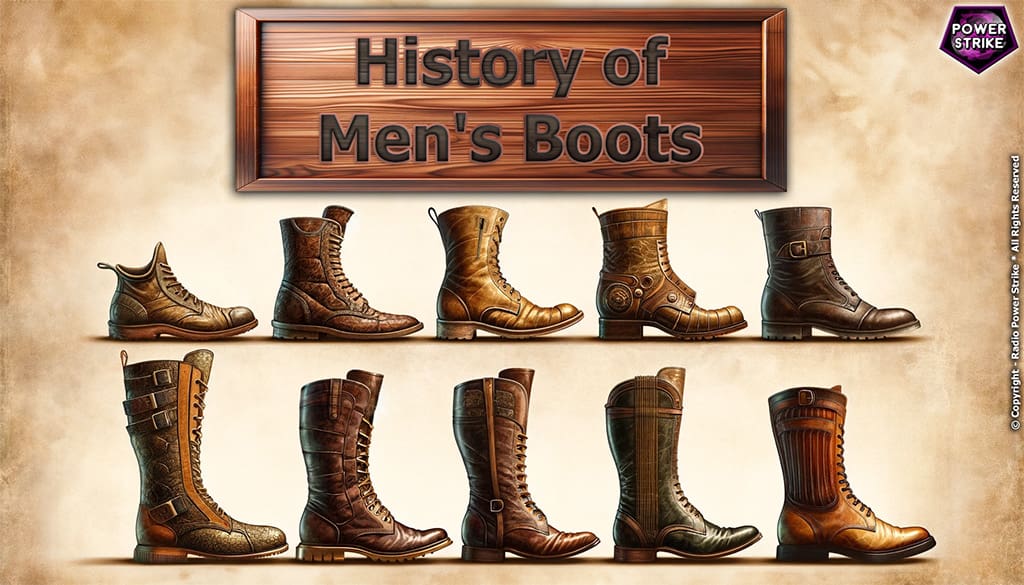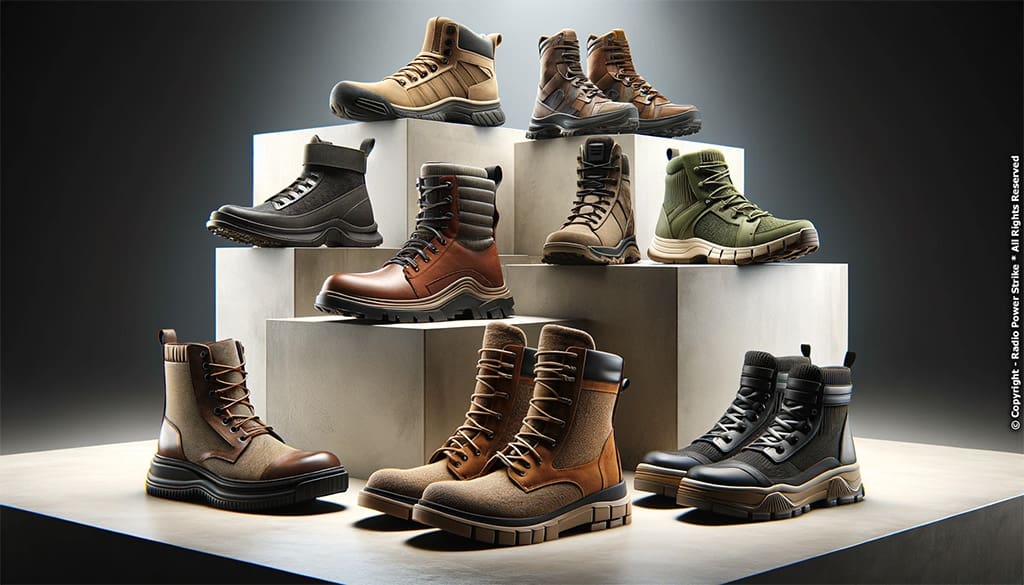The Fascinating History of Men’s Boots
From Practical Beginnings to Fashion Trends

Tracing the path from ancient hunting trails to contemporary catwalks, men’s boots have been a constant in human history. What began as a purely practical necessity has evolved into a symbol of style and personal expression. Each stitch and sole tells a story – a narrative of evolution and innovation.
Unraveling the history of men’s boots uncovers not just the evolution of design and function but also the rich cultural tapestry that has shaped our society. Boots are more than mere footwear; they are silent witnesses to social changes, technological advancements, and fashion revolutions.

Primitive Beginnings
The earliest evidence of boots dates back to ancient civilizations, where footwear was essential for protection in harsh conditions. Made from rudimentary materials like animal hides and leather, these early boots were designed for functionality, safeguarding feet from severe elements and uneven terrains. These initial boots marked the beginning of a long-standing relationship between man and this versatile footwear.
As societies evolved, so did boots. In Ancient Rome and Greece, boots began to take on more refined forms, adapting to the needs of different classes and occupations. From the Roman caligae, worn by soldiers, to the elaborate Greek boots, footwear reflected individuals’ social status and cultural identity.
Evolution Through the Ages
During the Middle Ages, boots became more sophisticated, reflecting advances in the art of shoemaking. With new tanning methods and improvements in construction, boots started to exhibit greater durability and comfort. This era also saw the emergence of specific styles for different activities, from hunting to combat.
The Renaissance brought a flourishing of fashion and the arts, influencing boot design as well. During this period, aesthetics began to hold as much importance as functionality. Elegant boots, adorned with details and made from fine leathers, became symbols of prestige and refinement.
Industrial Revolution and Innovation
The Industrial Revolution radically transformed boot manufacturing. The introduction of machinery and mass production allowed more people to access a wider variety of styles. During this period, boots became more affordable and diverse, catering to a broader range of tastes and needs.
This era of innovation wasn’t limited to production alone. New materials, like rubber and synthetic fabrics, began to be incorporated, expanding the possibilities for boot design and functionality. Rubber boots, for example, revolutionized footwear for wet and rainy environments.
Boots on the Battlefield
Military boots have a story of their own, intertwined with global events and soldiers’ field needs. From the trench boots of World War I to modern combat boots, each design reflects its era’s demands and challenges. These boots were designed to offer protection, durability, and support in extreme conditions.
The military influence on boot design crossed the boundaries of battlefields, seeping into civilian fashion. Many popular styles today, like combat boots and desert boots, have their roots in military gear.
Cultural Icons and Fashion
Men’s boots have been a prominent presence in the history of fashion, evolving from functional footwear to cultural style icons. Through the decades, various boot models have gained iconic status, reflecting the trends and values of each era.
In the global fashion scene, boots have come to represent more than just protection or utility. They have become a means for men to express individuality and personal style, whether in urban or rural settings. This transformation has been driven by various trends and cultural movements.
Cowboy Boots: Symbols of the Adventurous Spirit
- Origin and Evolution: Cowboy boots originated in the American Old West, created to meet the needs of cowboys. Over time, they transcended their practical utility, becoming icons of style and independence.
- Cultural Impact: These boots not only defined a lifestyle but also influenced international fashion with their distinctive design and association with the free and adventurous spirit.
Chelsea Boots: Elegance and Simplicity
- Popularity in the 60s: Chelsea boots gained popularity in the 60s, especially among musicians and artists. Their simple and elegant design made them a favorite choice for those seeking sophisticated style.
- Legacy and Influence: Today, Chelsea boots are synonymous with timeless fashion. They continue to be a popular choice for various occasions, combining comfort and elegance.
Modern Trends and the Future of Boots

In today’s world of fashion, men’s boots continue to evolve, incorporating modern trends and current concerns. Sustainability has become a key theme, with designers exploring eco-friendly materials and more responsible production processes. Additionally, technology plays an increasing role, with innovations in comfort, durability, and design.
The future of boots looks promising, with a continuation of tradition mixed with modernity. Functionality remains essential, but now intertwined with individual style expression and social awareness.
More Than Protection – A Symbol of Style
Men’s boots, from their humble beginnings to becoming key pieces in the world of fashion, reflect a journey of adaptation and innovation. They symbolize not just protection and practicality but also individuality, style, and cultural evolution. Looking back at this rich history, we recognize that boots are much more than mere footwear. They are a testament to human creativity and the relentless pursuit of perfection in form and function.

Comments are closed, but trackbacks and pingbacks are open.